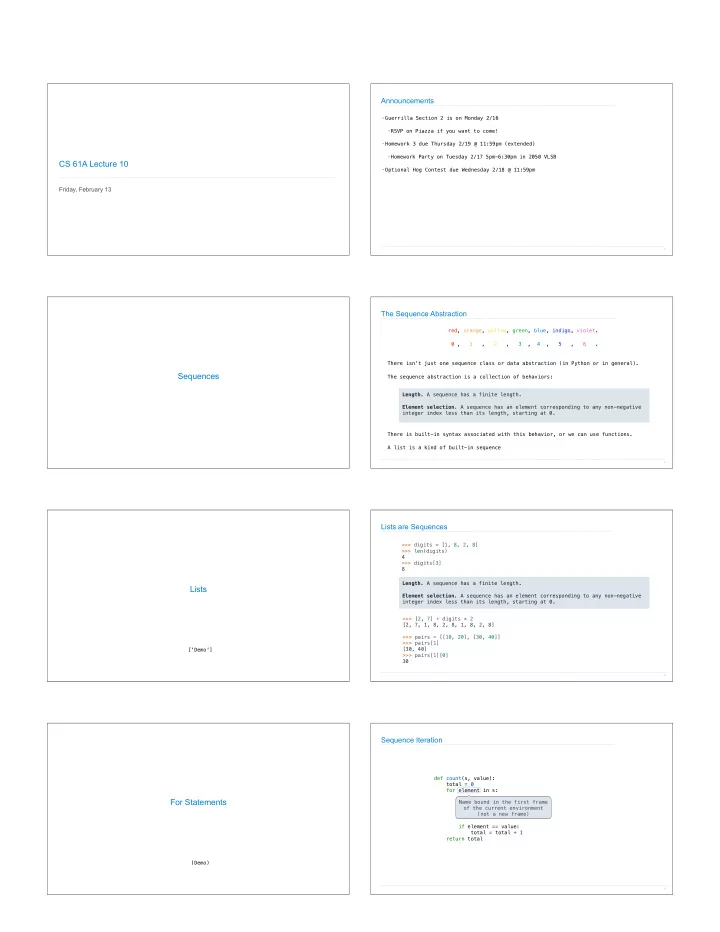

Announcements • Guerrilla Section 2 is on Monday 2/16 § RSVP on Piazza if you want to come! • Homework 3 due Thursday 2/19 @ 11:59pm (extended) § Homework Party on Tuesday 2/17 5pm-6:30pm in 2050 VLSB CS 61A Lecture 10 • Optional Hog Contest due Wednesday 2/18 @ 11:59pm Friday, February 13 2 The Sequence Abstraction red, orange, yellow, green, blue, indigo, violet. 0 , 1 , 2 , 3 , 4 , 5 , 6 . There isn't just one sequence class or data abstraction (in Python or in general). Sequences The sequence abstraction is a collection of behaviors: Length . A sequence has a finite length. Element selection . A sequence has an element corresponding to any non-negative integer index less than its length, starting at 0. There is built-in syntax associated with this behavior, or we can use functions. A list is a kind of built-in sequence 4 Lists are Sequences >>> digits = [1, 8, 2, 8] >>> len(digits) 4 >>> digits[3] 8 Length . A sequence has a finite length. Lists Element selection . A sequence has an element corresponding to any non-negative integer index less than its length, starting at 0. >>> [2, 7] + digits * 2 [2, 7, 1, 8, 2, 8, 1, 8, 2, 8] >>> pairs = [[10, 20], [30, 40]] >>> pairs[1] ['Demo'] [30, 40] >>> pairs[1][0] 30 6 Sequence Iteration def count(s, value): total = 0 for element in s: � For Statements Name bound in the first frame � of the current environment � (not a new frame) � � if element == value: total = total + 1 return total (Demo) 8
For Statement Execution Procedure Sequence Unpacking in For Statements A sequence of fixed-length sequences for <name> in <expression>: <suite> >>> pairs = [[1, 2], [2, 2], [3, 2], [4, 4]] � >>> same_count = 0 1. Evaluate the header <expression>, which must yield an iterable value (a sequence) A name for each element in a Each name is bound to a value, as in 2. For each element in that sequence, in order: fixed-length sequence multiple assignment A. Bind <name> to that element in the current frame >>> for x, y in pairs: ... if x == y: ... same_count = same_count + 1 B. Execute the <suite> � >>> same_count 2 9 10 The Range Type A range is a sequence of consecutive integers. * ..., -5, -4, -3, -2, -1, 0, 1, 2, 3, 4, 5, ... range(-2, 2) Ranges Length : ending value - starting value (Demo) Element selection : starting value + index >>> list(range(-2, 2)) List constructor [-2, -1, 0, 1] � >>> list(range(4)) Range with a 0 starting value [0, 1, 2, 3] * Ranges can actually represent more general integer sequences. 12 List Comprehensions [<map exp> for <name> in <iter exp> if <filter exp>] Short version: [<map exp> for <name> in <iter exp>] A combined expression that evaluates to a list using this evaluation procedure: List Comprehensions 1. Add a new frame with the current frame as its parent 2. Create an empty result list that is the value of the expression 3. For each element in the iterable value of <iter exp>: >>> letters = ['a', 'b', 'c', 'd', 'e', 'f', 'm', 'n', 'o', 'p'] A. Bind <name> to that element in the new frame from step 1 >>> [letters[i] for i in [3, 4, 6, 8]] ['d', 'e', 'm', 'o'] B. If <filter exp> evaluates to a true value, then add the value of <map exp> to the result list 14 Strings are an Abstraction Representing data: '200' '1.2e-5' 'False' '(1, 2)' Representing language: Strings """And, as imagination bodies forth The forms of things to unknown, and the poet's pen Turns them to shapes, and gives to airy nothing A local habitation and a name. """ Representing programs: 'curry = lambda f: lambda x: lambda y: f(x, y)' (Demo) 16
String Literals Have Three Forms Strings are Sequences Length and element selection are similar to all sequences >>> 'I am string!' 'I am string!' >>> city = 'Berkeley' � >>> len(city) Single-quoted and double-quoted >>> "I've got an apostrophe" 8 strings are equivalent "I've got an apostrophe" >>> city[3] Careful: An element of a string is itself a � 'k' string, but with only one element! >>> ' 您好 ' ' 您好 ' However, the "in" and "not in" operators match substrings >>> """The Zen of Python claims, Readability counts. >>> 'here' in "Where's Waldo?" Read more: import this.""" True 'The Zen of Python\nclaims, Readability counts.\nRead more: import this.' >>> 234 in [1, 2, 3, 4, 5] False >>> [2, 3, 4] in [1, 2, 3, 4, 5] A backslash "escapes" the "Line feed" character False following character represents a new line When working with strings, we usually care about whole words more than letters 17 18 Limitations on Dictionaries Dictionaries are unordered collections of key-value pairs Dictionary keys do have two restrictions: • A key of a dictionary cannot be a list or a dictionary (or any mutable type ) Dictionaries • Two keys cannot be equal; There can be at most one value for a given key This first restriction is tied to Python's underlying implementation of dictionaries The second restriction is part of the dictionary abstraction If you want to associate multiple values with a key, store them all in a sequence value {'Dem': 0} 20
Recommend
More recommend